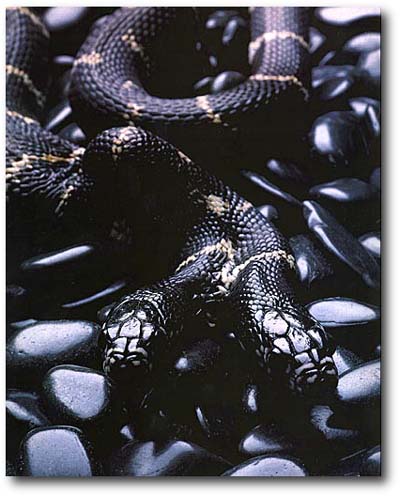
Our two headed kingsnake was first discovered as a baby under a toilet seat in the foothills of South Mountain. Not a very good beginning for our serpent. After several years it was loaned to the ASU reptile collection where it was cared for by Larry Nienaber. Larry is our long time animal care expert. With the special attention given our two headed friend, it lived a total of 17 years.
If you are wondering, 17 years is a long time for a kingsnake and for our two headed anomaly an especially long life. Typically king snakes live between 8 and 23 years in captivity. In the wild it would not have survived. Each head moved and thought independently, which lead to some problems. For one, it had trouble deciding which way to go. Much like two brothers might want to do different things only these brothers were attached. If you have brothers or sisters, you can imagine the struggles. Another problem is king snakes eat lizards in the wild. If both heads caught a lizard, the process could last all day and might result in one head swallowing the other... ugh.
How did our kingsnake end up with two heads? It would work in the same way identical twins develop. The snake was most likely a result of a single egg that did not fully split into two embryos before they hatched.
The two headed snake is gone, but not its neighbors in the ASU snake collection, which Nienaber says is the most complete native rattlesnake collection in the state. Most of the snakes are poisonous and were caught by either Nienaber or graduate students. Others were brought in by the Arizona Game and Fish Department and in one case discovered by someone doing some spring cleaning. The snake was curled around a bag of last years potting soil.
Read more about: The Tale of the Two-Headed Lampropeltis getula californiae
Bibliographic details:
- Article: Two Headed Friend
- Author(s): Dr. Biology
- Publisher: Arizona State University School of Life Sciences Ask A Biologist
- Site name: ASU - Ask A Biologist
- Date published:
- Date accessed:
- Link: https://askabiologist.asu.edu/content/two-headed-friend
APA Style
Dr. Biology. (). Two Headed Friend. ASU - Ask A Biologist. Retrieved from https://askabiologist.asu.edu/content/two-headed-friend
Chicago Manual of Style
Dr. Biology. "Two Headed Friend". ASU - Ask A Biologist. . https://askabiologist.asu.edu/content/two-headed-friend
Dr. Biology. "Two Headed Friend". ASU - Ask A Biologist. . ASU - Ask A Biologist, Web. https://askabiologist.asu.edu/content/two-headed-friend
MLA 2017 Style
Be Part of
Ask A Biologist
By volunteering, or simply sending us feedback on the site. Scientists, teachers, writers, illustrators, and translators are all important to the program. If you are interested in helping with the website we have a Volunteers page to get the process started.


